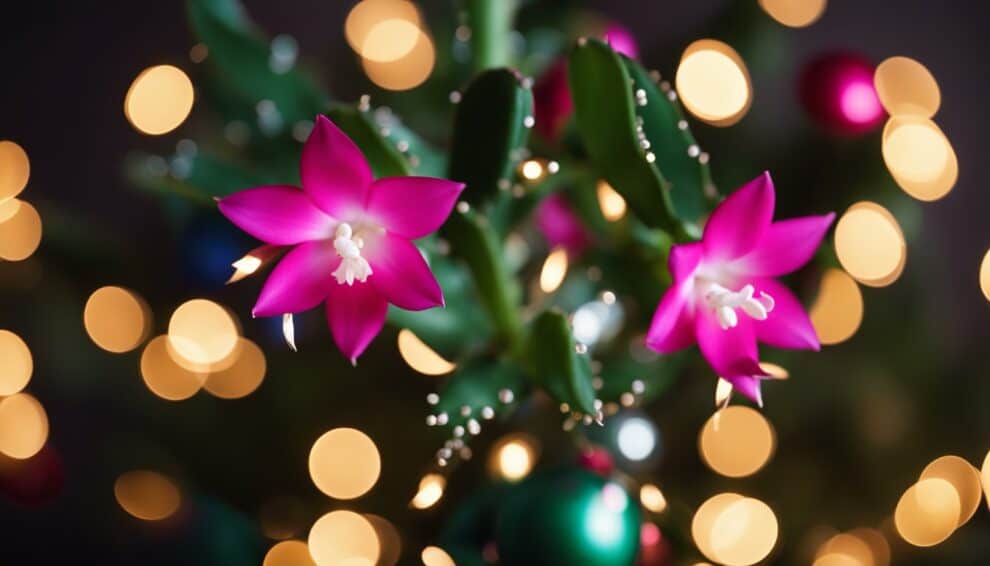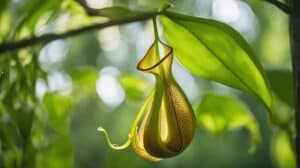The holiday season is a time for joy and cheer, and what better way to spread the holiday spirit than by propagating a Christmas cactus (Schlumbergera bridgesii). These beautiful plants are known for their vibrant blooms that add a festive touch to any room. With a little bit of knowledge and patience, anyone can successfully propagate these plants and share their beauty with others.

Propagation of the Christmas cactus can be done through stem cuttings, which involves taking a section of the plant and encouraging it to grow roots and new shoots. This process can be done at any time of the year, but it is best to do it in the spring or summer when the plant is actively growing. With the right conditions, the cuttings will root and grow into new plants that can be given as gifts or used to brighten up your own home.
To successfully propagate a Christmas cactus, it is important to provide the right growing conditions. This includes using well-draining soil, keeping the plant in bright but indirect light, and maintaining a consistent watering schedule. With a little bit of care and attention, anyone can enjoy the beauty of these plants and spread the holiday spirit throughout the year.
Understanding Christmas Cactus
Species Overview
Christmas cactus (Schlumbergera bridgesii) is a popular houseplant that is native to the rainforests of Brazil. It belongs to the cactus family, but unlike other cacti, it does not have spines. Instead, it has flattened, segmented stems that resemble leaves. The stems are dark green and can grow up to 3 feet long.
The plant is called a “Christmas cactus” because it blooms during the holiday season. Its flowers are usually pink, red, white, or a combination of these colors. The flowers are tubular and have long stamens that protrude from the petals. They are also fragrant and can last for several weeks.
Growth Habits
Christmas cactus is an epiphyte, which means it grows on other plants in its natural habitat. It is also a tropical plant, so it prefers warm, humid environments. In the wild, it grows in the shade of trees, so it does not require direct sunlight.
The plant is easy to care for and can live for many years with proper care. It prefers well-draining soil and should be watered regularly but not overwatered. Overwatering can cause the roots to rot and the plant to die.
Christmas cactus can be propagated by stem cuttings. The cuttings should be taken in the spring or summer and allowed to dry for a few days before being planted in soil. The plant can also be propagated by division, which involves separating the stems of an established plant and planting them in separate pots.
Overall, Christmas cactus is a beautiful and easy-to-care-for plant that can add a festive touch to any home during the holiday season.
Propagation Basics

Best Time for Propagation
The best time to propagate Christmas cactus is during the spring or summer months when the plant is actively growing. During this time, the plant is better able to recover from the stress of propagation and will have a higher chance of success.
Required Tools and Materials
To propagate Christmas cactus, you will need the following tools and materials:
- Pruning shears or sharp, clean scissors
- Small pots or containers with drainage holes
- Potting soil mix
- Perlite or sand
- Rooting hormone (optional)
Before propagating, make sure your tools and containers are clean and free of any harmful bacteria or fungi. It is also important to use a well-draining potting mix that will not retain too much moisture, as this can lead to root rot.
If using rooting hormone, be sure to follow the instructions carefully and apply it to the cuttings before planting them in the soil mix. This can help stimulate root growth and increase the chances of successful propagation.
By following these simple basics, anyone can successfully propagate a Christmas cactus and share the holiday spirit with friends and family.
Propagation Methods

Christmas cactus can be propagated through stem cuttings, division, or seeding.
Stem Cuttings
The stem cuttings method is the most common and easiest way to propagate Christmas cactus. Follow these steps:
- Cut a healthy stem from the parent plant, making sure it is at least 2-3 segments long.
- Let the cutting dry for a few hours so that the wound can heal and prevent rotting.
- Dip the cut end of the stem in rooting hormone powder to encourage root growth.
- Plant the stem cutting in a well-draining soil mix and water it sparingly until roots are established.
Division
Division is another method of propagating Christmas cactus. This method is best done when the plant has become too big for its pot. Follow these steps:
- Carefully remove the plant from its pot and gently shake off the excess soil.
- Divide the plant into smaller sections, making sure each section has healthy stems and roots.
- Repot each section in a well-draining soil mix and water sparingly until roots are established.
Seeding
Seeding is the least common method of propagating Christmas cactus, but it can be done. Follow these steps:
- Collect seeds from a mature Christmas cactus plant.
- Sow the seeds in a well-draining soil mix and cover them lightly with soil.
- Keep the soil moist and warm, and the seeds should germinate within a few weeks.
- Once the seedlings have grown big enough, transplant them into individual pots.
Aftercare and Tips

Post-Propagation Care
Once the Christmas cactus cuttings have rooted and started to grow, it’s important to take good care of them. Here are some tips for post-propagation care:
- Watering: Water the newly propagated plants regularly, but be careful not to overwater them. Allow the soil to dry out slightly between waterings. Overwatering can lead to root rot and other problems.
- Lighting: Place the new plants in a bright, indirect light. Avoid direct sunlight, as it can burn the leaves. A north or east-facing window is usually a good location.
- Temperature: Keep the plants in a warm location, ideally between 60 and 70 degrees Fahrenheit. Avoid exposing them to cold drafts or extreme temperatures.
- Fertilizing: Once the plants have started to grow, you can fertilize them with a balanced houseplant fertilizer. Follow the instructions on the package for best results.
Troubleshooting Common Issues
Even with the best care, Christmas cacti can sometimes run into problems. Here are some common issues and how to troubleshoot them:
- Yellowing Leaves: If the leaves of your Christmas cactus turn yellow, it may be a sign of overwatering. Allow the soil to dry out more between waterings, and make sure the pot has good drainage.
- Drooping Leaves: If the leaves of your Christmas cactus are drooping, it may be a sign of underwatering. Give the plant a good drink of water and make sure the soil is evenly moist.
- No Blooms: If your Christmas cactus isn’t blooming, it may be due to a lack of light or improper temperature. Make sure the plant is getting enough bright, indirect light and is in a warm location. Additionally, avoid moving the plant around too much or exposing it to drafts, as this can also prevent blooming.
By following these tips and troubleshooting common issues, you can help ensure that your newly propagated Christmas cactus plants thrive and bring holiday cheer for years to come.
Frequently Asked Questions

How can I successfully propagate my Christmas Cactus using water?
To propagate a Christmas Cactus using water, you will need to take a cutting from the plant and place it in a jar or vase filled with water. Make sure the water covers the base of the cutting but does not submerge the entire cutting. Change the water every few days to prevent bacteria growth. Once roots have formed, you can transfer the cutting to soil.
What are the steps to propagate a Christmas Cactus in soil?
To propagate a Christmas Cactus in soil, you will need to take a cutting from the plant and let it callus over for a few days. Then, dip the base of the cutting in rooting hormone and plant it in a well-draining soil mix. Keep the soil moist but not waterlogged and place the cutting in a bright, indirect light. Roots should form within a few weeks.
When is the ideal time of year to propagate a Christmas Cactus?
The ideal time to propagate a Christmas Cactus is in the spring or summer when the plant is actively growing. Avoid propagating during the winter months when the plant is dormant.
Can I plant Christmas Cactus cuttings directly into soil without rooting them first?
While it is possible to plant Christmas Cactus cuttings directly into soil without rooting them first, it is not recommended. Rooting hormones increase the chances of successful propagation and help the cutting establish roots more quickly.
What should I do if my Christmas Cactus cuttings become limp?
If your Christmas Cactus cuttings become limp, it may be a sign of overwatering or underwatering. Check the soil moisture and adjust watering as needed. You can also try misting the cuttings to increase humidity around the plant.
Are there any legal restrictions on propagating Christmas Cactus plants?
There are no legal restrictions on propagating Christmas Cactus plants for personal use. However, it is illegal to propagate and sell patented varieties without a license from the patent holder.













